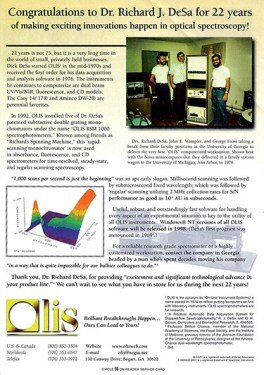All about Uv/vis/nir
Table of ContentsFacts About Spectrophotometers UncoveredGetting The Spectrophotometers To WorkThe 10-Minute Rule for Uv/vis/nirExcitement About Circularly Polarized LuminescenceNot known Facts About Spectrophotometers

Although spectrophotometry is most commonly applied to ultraviolet, noticeable, and infrared radiation, contemporary spectrophotometers can question broad swaths of the electro-magnetic spectrum, consisting of x-ray, ultraviolet, noticeable, infrared, and/or microwave wavelengths. Spectrophotometry is a tool that depends upon the quantitative analysis of particles depending upon just how much light is absorbed by colored substances.
The 7-Minute Rule for Uv/vis/nir
A spectrophotometer is frequently utilized for the measurement of transmittance or reflectance of solutions, transparent or opaque solids, such as refined glass, or gases. Lots of biochemicals are colored, as in, they absorb noticeable light and for that reason can be measured by colorimetric procedures, even colorless biochemicals can frequently be transformed to colored compounds ideal for chromogenic color-forming reactions to yield compounds ideal for colorimetric analysis.: 65 Nevertheless, they can likewise be developed to determine the diffusivity on any of the listed light ranges that normally cover around 2002500 nm utilizing various controls and calibrations.
An example of an experiment in which spectrophotometry is used is the decision of the equilibrium constant of a service. A particular chain reaction within an option may take place in a forward and reverse direction, where reactants form items and products break down into reactants. At some point, this chain reaction will reach a point of balance called an equilibrium point.
The Only Guide to Circularly Polarized Luminescence
The amount of light that goes through the solution is a sign of the concentration of certain chemicals that do not permit light to pass through. The absorption of light is because of the interaction of light with the electronic and vibrational modes of particles. Each kind of particle has a private set of energy levels related to the makeup of its chemical bonds and nuclei and thus will take in light of particular wavelengths, or energies, resulting in distinct spectral homes.
They are widely used in lots of markets including semiconductors, laser and optical production, printing and forensic evaluation, as well as in labs for the study of chemical substances. Spectrophotometry is often utilized in measurements of enzyme activities, determinations of protein concentrations, decisions of enzymatic kinetic constants, and measurements of ligand binding reactions.: 65 Ultimately, a spectrophotometer is able to identify, depending on the control or calibration, what compounds are present in a target and precisely how much through calculations of observed wavelengths.
Invented by Arnold O. Beckman in 1940 [], the spectrophotometer was created with the help of his coworkers at his business National Technical Laboratories established in 1935 which would become Beckman Instrument Business and eventually Beckman Coulter. This would come as an option to the formerly created spectrophotometers which were not able to take in the ultraviolet properly.
The smart Trick of Circular Dichroism That Nobody is Discussing
It would be found that this did not provide satisfactory outcomes, for that reason in Design B, there was a shift from a glass to a quartz prism which permitted much better absorbance outcomes - circularly polarized luminescence (https://dzone.com/users/5082179/olisclarity1.html). From there, Model C was born with an adjustment to the wavelength resolution which ended up having three units of it produced
It irradiates the sample with polychromatic light which the sample absorbs depending upon its residential or commercial properties. Then it is transmitted back by grating the photodiode selection which discovers the wavelength region of the spectrum. Because then, the production and implementation of spectrophotometry gadgets has increased profoundly and has turned into one of the most ingenious instruments of our time.

The Uv/vis/nir Ideas
Historically, spectrophotometers use a monochromator including a diffraction grating to produce the analytical spectrum. The grating can either be movable or repaired. If a single detector, such as a photomultiplier tube or photodiode is utilized, the grating can be scanned step-by-step (scanning spectrophotometer) so that the detector can measure the light strength at each wavelength (which will correspond to each "step").
In such systems, the grating is repaired and the strength of each wavelength of light is measured by a various detector in the range. Furthermore, most modern-day mid-infrared spectrophotometers use a Fourier change technique to get the spectral details - https://soundcloud.com/julieanndesalorenz30606. This method is called Fourier change infrared spectroscopy. When making transmission measurements, the spectrophotometer quantitatively compares the portion of light that goes through a recommendation service and a test service, then digitally compares the intensities of the 2 signals and calculates the percentage of transmission of the sample compared to the reference standard.
